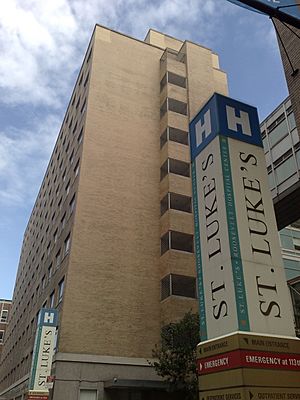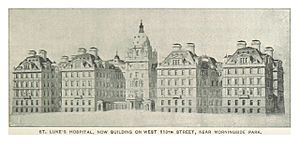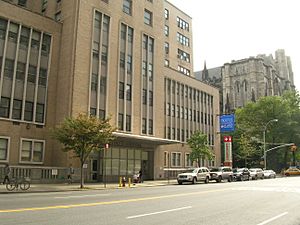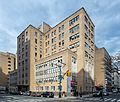Mount Sinai Morningside facts for kids
Quick facts for kids Mount Sinai Morningside |
|
|---|---|
| Mount Sinai Health System | |

Mount Sinai Morningside
|
|
| Geography | |
| Location | 1111 Amsterdam Avenue, New York City, New York 10027, United States |
| Coordinates | 40°48′20″N 73°57′42″W / 40.8055°N 73.9618°W |
| Organization | |
| Care system | Private |
| Hospital type | Tertiary teaching hospital |
| Affiliated university | Icahn School of Medicine at Mount Sinai |
| Network | Mount Sinai Health System |
| Services | |
| Emergency department | Level 2 trauma center |
| Beds | 495 |
| History | |
| Founded | 1850 |
Mount Sinai Morningside is a large hospital in New York City. It is located in the Morningside Heights area of Manhattan. The hospital is part of the Mount Sinai Health System. It also works with the Icahn School of Medicine at Mount Sinai.
This hospital is a place where doctors learn and practice. It offers many medical and surgical services. It also has a special emergency room called a Level 2 Trauma Center. This means it can handle serious injuries. The hospital was first started in 1850. It was known as St. Luke's Hospital for a long time. Later, it was called Mount Sinai St. Luke's. In 2020, its name changed to Mount Sinai Morningside.
Mount Sinai Morningside helps people in the Upper West Side and western Harlem neighborhoods. It has 21 different clinics. In 2020, it was ranked among the best hospitals in the U.S. for treating diabetes and kidney problems.
The main hospital building was built in 1896. It was designed by Ernest Flagg. Over the years, more buildings were added. Some parts of the hospital are now official New York City landmarks. Other original buildings are listed on the National Register of Historic Places.
Contents
What Services Does the Hospital Offer?
Mount Sinai Morningside offers many types of medical care. Besides regular doctor visits, it has 21 special clinics. These clinics help with specific health issues.
Some of the main areas they focus on include:
- Heart care and heart surgery
- Cancer treatment
- Weight loss surgery and diabetes care
- Care for older adults (geriatrics)
- Brain and nerve problems (neurology)
The hospital has 495 beds for patients. In 2019, it provided care for patients for 97,000 days. About 14,000 patients were admitted and then left the hospital. The emergency room had over 90,000 visits that year.
Emergency Department
The emergency department is open 24 hours a day. It has doctors, nurses, and other staff who are experts in emergency medicine. They can help with all kinds of urgent medical needs.
The hospital also has special teams for emergencies. These include:
- A 24-hour stroke team for brain emergencies.
- A Heart Attack (MI) Team for heart emergencies.
- A 24-hour lab for cardiac catheterization, which helps with heart problems.
- Special emergency care for children.
- Help for mental health emergencies.
Training for Doctors
Mount Sinai Morningside helps train new doctors. It has 30 different training programs. These are called residency programs. For example, its Internal Medicine program is one of the largest in New York State. It teaches doctors how to care for adult patients.
The hospital uses special ways to help doctors learn. They make sure doctors can learn from every patient they see. They also limit how many patients a new doctor (intern) can care for. This helps ensure doctors get good training without being too overwhelmed. The hospital even has a special lab for practicing medical procedures.
Hospital History
How It Started
St. Luke's Hospital was started by William Augustus Muhlenberg. He was a pastor who wanted to help poor and sick people in New York City. He began raising money in 1846.
- 1850: St. Luke's Hospital was officially created. It was only the fourth general hospital in New York City.
- 1853: The hospital welcomed its first patients. It was first located inside a church building.
- 1858: St. Luke's moved to a new building on Fifth Avenue. This building was designed in the Romanesque Revival style.
As New York City grew, the area around the hospital became very busy. The hospital also needed more space. So, they started looking for a new location.
A New Home
In 1891, the hospital decided to move to Morningside Heights. This new spot was next to the Cathedral of St. John the Divine. The hospital liked this location because it was high up and close to Morningside Park.
Many architects submitted designs for the new hospital. The winning design came from Ernest Flagg. His plan was different from the others. It used the French Renaissance Revival style.
- May 1893: Construction began on the new hospital.
- January 1896: The first patients started moving into the new buildings.
- Late 1896: Construction was finished. The new hospital cost about $1.7 million.
Growing Bigger
After the main buildings were finished, the hospital continued to grow. They needed more space, especially for patients who could pay for private rooms.
- 1906: The Plant Pavilion opened. This building was for private patients.
- 1908–1911: The Travers Pavilion was built. It was used for outpatients and staff.
- 1928: The Scrymser Pavilion opened. This was another building for private patients. It was one of Ernest Flagg's last designs in Manhattan.
Recent History
After World War II, the hospital added more modern buildings. Some of the older pavilions were taken down.
- 1952: Woman's Hospital joined St. Luke's Hospital. They formed the St. Luke's Hospital Center.
- 1978: St. Luke's Hospital merged with Roosevelt Hospital. They became the St. Luke's–Roosevelt Hospital Center.
- 2013: St. Luke's–Roosevelt Hospital Center joined the Mount Sinai Health System.
- 2015: The hospital was renamed Mount Sinai St. Luke's.
- 2016: Four of the original pavilions were sold. They were turned into apartments.
- 2019: The remaining original hospital buildings were listed on the National Register of Historic Places.
- 2020: The hospital was renamed Mount Sinai Morningside.
Hospital Buildings
Ernest Flagg designed St. Luke's Hospital with nine separate buildings. These were called pavilions. They were connected by elevated walkways. This design allowed fresh air to move through the hospital. Patient rooms were on one side, and nurses' rooms and private patient wings were on the other.
Eight of Flagg's pavilions were built. Six of these still stand today. Four of them are no longer part of the hospital.
Administration Building
The main administration building is also called the Muhlenberg Pavilion. It was one of the first buildings to open in 1896. It used to have a large dome on top, like the Luxembourg Palace. This dome was taken down in 1966.
Chapel Pavilion
The Chapel Pavilion is on 114th Street. It opened in 1896. Ernest Flagg designed the chapel and its beautiful stained glass windows. The chapel is 70 feet long and 30 feet wide.
Travers Pavilion
The Travers Pavilion was built between 1908 and 1911. It was used for patients who did not need to stay overnight. It also had dorms for female hospital staff. Later, it became offices and then apartments.
Plant and Scrymser Pavilions
These two pavilions are on Morningside Drive.
- The Plant Pavilion opened in 1906.
- The Scrymser Pavilion opened in 1928.
They were built for wealthy patients who wanted private rooms. The Plant Pavilion has eight stories. The Scrymser Pavilion has nine stories. It looks a bit different from the other buildings. Both were turned into apartments starting in 2016.
Minturn Pavilion
The Minturn Pavilion is on 113th Street. It was one of the first buildings to open in 1896. It was named after Robert Minturn, the hospital's first president. It was first used for women's surgery. Later, it became offices and then apartments.
Norrie and Vanderbilt Pavilions
These two pavilions were also among the first to open in 1896.
- The Norrie Pavilion was for men's surgery.
- The Vanderbilt Pavilion was for staff dorms.
Both of these buildings were taken down in the 1950s.
Other Hospitals That Joined
Woman's Hospital
Woman's Hospital was founded by Dr. J. Marion Sims. It focused on treating women's health issues. It was one of the first hospitals of its kind.
- It started in a rented house.
- In 1867, it moved to a new building on Park Avenue.
- In 1906, it moved again to 110th Street and Amsterdam Avenue.
- In 1952, Woman's Hospital joined St. Luke's Hospital.
- In 1965, it moved to 114th Street and Amsterdam Avenue, across from St. Luke's.
St. Luke's Hospital Training School for Nurses
This school trained nurses from 1888 until 1974. It helped over 4,000 nurses get their training. The school closed because more nurses started getting four-year college degrees.
Cool Innovations and Discoveries
Doctors at this hospital have made many important medical advances:
- 1935: Surgeons performed one of the first successful removals of a cancerous lung.
- 1956: The first open heart surgery to fix a hole in the heart was done in New York City.
- 1958: Dr. Doris L. Wethers became the first Black attending physician. She pushed for testing all children for sickle cell disease. This became a standard practice across the U.S. by 2006.
- 1960: Doctors found the first drug to lower cholesterol.
- 1967: A new device was described to fix certain leg bone fractures.
- 1968: Doctors described how red blood cells in people with sickle cell disease can stay sickled.
- 1974: The first surgery to remove fibroids from the uterus using a special camera was performed.
- 1975: The first research center for obesity in the U.S. was founded here.
- The first hospital-based hospice program in the U.S. was started here. Hospice helps people with serious illnesses.
- 1982: Doctors were among the first to notice a strange problem with the immune system in some men. This problem was later found to be related to HIV.
Images for kids





